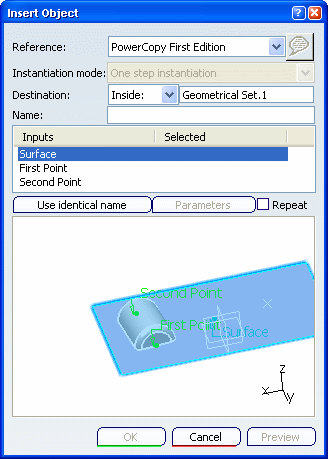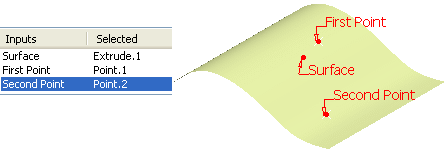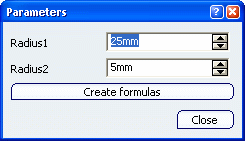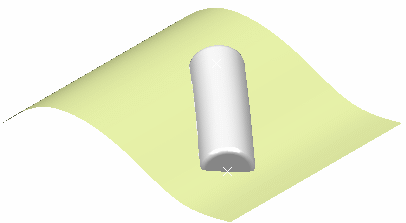From the reference document, click Instantiate From Selection
 .
.
Select the power copy from the destination document.
The Insert Object dialog box appears. Warning or error messages can be issued if the chosen
destination is ambiguous or forbidden, for instance if you select an
ordered geometrical set as the After destination.
-
In case
of an error message, the destination field is emptied and the OK button is unavailable.
-
In
case of a warning message, the power copy can still be instantiated
but some elements may not be inserted in the chosen destination.
Use the Reference list to
choose the correct Power Copy when several have been defined in the
document.
The One step instantiation mode is automatically
selected when working in a non ordered environment. If you work in an
ordered environment, you can choose the mode.

Select the Destination
of the instantiation.
It is
composed of two elements: a combo list corresponding to the relative
position (Inside or After) and a field
containing the destination feature.
The destination depends on the current feature
as it is automatically filled with the latter. If
there is no current feature, the field is empty.
-
When
possible, you can modify the default destination, either by
modifying the relative position or by selecting another destination
feature.
-
The
destination is filled with
After when the destination is
a geometric feature. In this case, the After field is
grayed out.
-
The
destination is filled with
Inside when the destination
is a geometrical feature set.
Complete the Inputs within the dialog box by
selecting the adequate element in the geometric area.
After each selection, an indicator is displayed in the 3D area, with orientation when necessary. Click on the green arrow to
reverse orientation if needed.

If needed, click Use identical name to
automatically select all the elements with the same name.
You can also click Parameters to display
the Parameters dialog box and modify values.
Here we increased the Radius1 value to 25 mm.

Click Create formulas to automatically create a
formula for every parameters with the same name provided there are any.
Click Close.
Click OK to finish the instantiation.
The Power Copy is instantiated in context, meaning
its limits are automatically re-defined taking into account the
elements on which it is instantiated.
